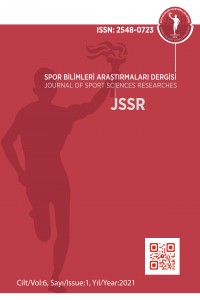Araştırma Makalesi
Yıl 2021,
Cilt: 6 Sayı: 1, 173 - 183, 30.06.2021
Öz
The aim of this study is to examine the goal commitment levels of the Faculty of Sport Sciences students in terms of different variables. Survey model -which is the one of the quantitative research models- was used in this study. A total of 348 volunteer students, 248 males and 100 females, studying at the Faculty of Sport Sciences of Ağrı İbrahim Çeçen University in the academic year of 2020-2021, participated in the study. Scale usage and ethics committee permissions were obtained in order to conduct the research. The 'Goal Commitment' (Şenel & Yıldız, 2016) scale was used to collect data, except for personal information forms. Descriptive statistics (frequency, mean, standard deviation), Mann Whitney U and Kruskal-Wallis H tests were used to analyze the data. The obtained results were evaluated according to the significance of p <.05. When the findings of the study are evaluated, it was found that female students goal commitment levels were higher than male students' goal commitment levels. In the study, it was concluded that goal commitment levels of students from families with a monthly income of 2501-4000 TL was higher than the level of goal commitment of the students from families with a monthly total income of 1500 TL or less. According to the findings obtained after the research, there is no significant differentiation between the students' goal commitment levels and their ages, family structures, places of residence with their families, and whether the department that the students got admitted was intended by them prior to the admission. As a result, it was concluded that the goal commitment levels of the students varies according to various sociocultural and socioeconomic characteristics.
Anahtar Kelimeler
Kaynakça
- Arends, R. I., & Kilcher, A. (2010). Teaching for Student Learning: Becoming an Accomplished Teacher. Routledge: New York, London.
Yıl 2021,
Cilt: 6 Sayı: 1, 173 - 183, 30.06.2021
Öz
Bu çalışmanın amacı, Spor Bilimleri Fakültesi öğrencilerinin hedef bağlılığı düzeylerini farklı değişkenler açısından incelemektir. Çalışmada, nicel araştırma modellerinden biri olan tarama (survey) modeli kullanılmıştır. Araştırmaya 2020-2021 eğitim-öğretim yılında Ağrı İbrahim Çeçen Üniversitesi, Spor Bilimleri Fakültesi’nde öğrenim gören 248’si erkek ve 100’ü kadın olmak üzere toplam 348 gönüllü öğrenci katılmıştır. Araştırmanın yapılabilmesi için ölçek kullanım ve etik kurul izinleri alınmıştır. Veri toplamak amacıyla kişisel bilgi formları dışında ‘Hedef Bağlılığı’ (Şenel ve Yıldız, 2016) ölçeği kullanılmıştır. Verilerin analizinde betimsel istatistikler (frekans, aritmetik ortalama, standart sapma), Mann Whitney U, ve Kruskal-Wallis H testleri kullanılmıştır. Sonuçlar ise p<.05 anlamlılık düzeyine göre değerlendirilmiştir. Araştırmanın bulguları değerlendirildiğinde kadın öğrencilerin hedef bağlılığı düzeylerinin erkek öğrencilerin hedef bağlılığı düzeylerinden daha yüksek olduğu sonucu elde edilmiştir. Çalışmada ayrıca 2501-4000 TL arası aylık toplam gelire sahip ailelere mensup öğrencilerin hedef bağlılığı düzeylerinin 1500 TL ve altında aylık toplam gelire sahip ailelere mensup öğrencilerin hedef bağlılığı düzeylerinden daha yüksek olduğu tespit edilmiştir. Araştırma sonrasında elde edilen bulgulara göre, öğrencilerin hedef bağlılık düzeyleri ile yaşları, aile yapıları, aileleriyle birlikte ikamet edilen yerleşim yerleri ve kayıtlı olunan bölümün önceden hedeflenip hedeflenmediği durumları arasında anlamlı bir farklılaşma yoktur. Çalışmamızın örneklem grubunu oluşturan öğrencilerin hedef bağlılığı düzeylerinin çeşitli sosyokültürel ve sosyoekonomik özelliklere göre farklılık gösterdiği sonucu elde edilmiştir.
Anahtar Kelimeler
Kaynakça
- Arends, R. I., & Kilcher, A. (2010). Teaching for Student Learning: Becoming an Accomplished Teacher. Routledge: New York, London.
Toplam 1 adet kaynakça vardır.
Ayrıntılar
| Birincil Dil | Türkçe |
|---|---|
| Konular | Spor Hekimliği |
| Bölüm | Orijinal Makale |
| Yazarlar | |
| Yayımlanma Tarihi | 30 Haziran 2021 |
| Kabul Tarihi | 18 Mayıs 2021 |
| Yayımlandığı Sayı | Yıl 2021 Cilt: 6 Sayı: 1 |



